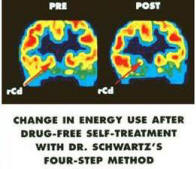Every man can, if he so desires, become the sculptor of his own brain. – Santiago Ramon Y Cajal
After completing much research, modern neuroscience has finally come to the inevitable conclusion that we can actually stop suffering, heal illnesses and improve our wellbeing by training our brains and mind to think differently. All this is possible because of a brain process called neuroplasticity.
Neuroplasticity is the lifelong capacity of the brain to change and rewire itself. Neuroplasticity happens in response to different stimulations: learning, life experiences, new feelings and emotions.
Why this is possible?
It is possible because new neurons (brain cells) continue to grow throughout our whole life, even at very old age. Moreover, neurons constantly create new connections between themselves as a result of new life experiences. It basically looks like this: New Experiences = New neurons + New Connections between Neurons.
Can the brain changes be measured and seen?

Brain scan
Yes, these brain changes can be physically measured and seen on brain scanners like MRI, PET, EEG, MEG and others. Now we can see the result of psychotherapy (counselling, brain exercises and the like) using brain scanning techniques.
What kind of illnesses and conditions can be helped with Neuroplasticity?
Most conditions where the brain is involved (mental, emotional, spiritual and even physical) can get better with appropriate brain training. These are: OCD, eating disorders, different fears and phobias, anxiety, depression, strokes, brain traumas, addictions, obsessions and much more.
Are there any negative effects of neuroplasticity?
The ability of the brain to change itself is certainly good news. It makes the brain more resourceful and powerful than originally thought. But it also makes the brain more vulnerable to outside influences producing more rigid and negative behaviours.
Many of our bad habits and conditions are the result of the brain plasticity. Anything that involves unvaried repetition – our careers, culture, home environment, personal habits, even personal thoughts and feelings can lead to rigid behaviours.
For example, repetitive negative feelings about yourself and your body can lead to eating disorders. Prolong personal dissatisfaction with the environment, home and close people can lead to obsessions and different kinds of addictions. Many demanding jobs which involve too much thinking and planning can produce bad habits of over rationalising everything and losing the connection to our intuition and the feelings in our heart. Some cultures produce rigid behaviours in people based on religion and cultural views. All our neuroses are the product of neuroplasticity.
How to use neuroplasticity to achieve the best results?
First of all it is important to understand the content of your mind: to know what are the rigid negative behaviours you need to change, or what positive habits you want to develop. The second crucial step is to refocus on a positive, wholesome, ideally pleasure –giving behaviour (activity) which will replace the negative behaviour.
When you work with neuroplasticity, it is not what you feel while you are practicing neuro-plastic exercises; it is what you do that counts? The main struggle is not to give in to the feelings.
With neuroplasticity the more you do it, the more you want to do it, and the less you do it, the less you want to do it, will make all the difference to the outcome.
A strong desire to change your brain is required or at least some sort of motivation to change.
Can all people’s brain be changed with neuroplasticity?
Yes, basically everyone’s brain can be changed to the certain level. The limits of changing ones brain is unpredictable and totally depends on ones desire to change, the effort put into the changing process, the supportive environment and the general health of the person can make a difference.
The extent of damage to the brain from previous bad programming also plays a role. But don’t despair; it is also well known that some very badly damaged brains recover well and sometimes even better than the brains with lesser damage.
